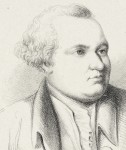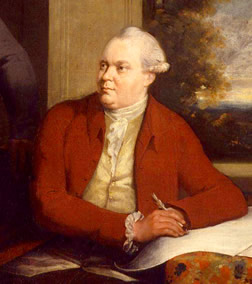|
Date of Birth |
19 February 1733. |
Place of Birth 
|
Piteå, Gammelstad, Norrbotten, Sweden. |
|
Date of Death |
8 May 1782. |
Place of Death 
|
London, England. |
Monuments Medals Etc. 
|
- Memorial stone, Woking close to London, erected by The Royal Swedish Academy of Sciences, Stockholm 1913.
- Memorial stone, erected 1914 in Botany Bay, Australia, besides James Cook’s monument.
- Memorial stamp, the French Post office 1986. The stamp depicts James Cook’s map over Tahiti added with portraits of Daniel Solander and Anders Sparrman.
- Memorial stamps 2001, distributed at the same time by the Swedish and Australian Post Offices. One of the stamps depicting Daniel Solander at his working desk and the other the ship Endeavour.
|
|
Variations of Name's Spelling |
Solander signed some of
his letters, with his first name in an abbreviated form or
with the first letter of his middle name, (Dan. Solander
or Daniel C. Solander). |
|
Preserved signature |
In correspondence. |
|
Portrait |
Solander can be studied on both portraits
and group-pictures, in a wide range of representations
made during his life time as well as long after his death.

Portrait of Daniel Solander, lithograph; after an oil painting from 1777 by John (Johann)
Zoffany.
[Source; Rare Book and Fine Printing Collection, Alexander Turnbull Library, National Library of New Zealand].

Oil on canvas 1768 by Thomas Luny. Depicting the bark
Earl of Pembroke later Endeavour, leaving Whitby Harbour
in 1768. National Library of Australia.

Painting 1772 by John Clevely, depicting Joseph Banks
and Daniel Solander in an Icelandic house. The Linnean
Society of London, England.

Oil on canvas c. 1776 by John (Johann) Zoffany. The
Linnean Society of London.

Oil on canvas c. 1776 by William Parry. “Banks introduces
Omai to Solander”. National museums and Galleries
of Wales. Copy in The Royal Swedish Academy of
Sciences, Stockholm.

Oil on canvas c. 1777 by James Cleveby. Discovery and
Resolution at an island in the Pacific. National Library of
Australia.

Oil on canvas by John Hamilton Mortimer (1740-79).
Captain Cook, Joseph Banks and Daniel Solander among
others depicted. National Library of Australia.

Oil on canvas 1902 by Phillips Fox. Landing of Captain
Cook at Botany Bay, Solander is one of the depicted. National
Gallery of Victoria.

Miniature paining of Solander by Daniel Nikolaus Chodowiecki.
Staatliche Museen, Berlin, Germany.

Medallion of Daniel Solander, made by Josiah Wedgwood’s
manufacture. Private ownership, Sweden. |
|
Childhood, Adolescence & Education |
- Father, vicar Carl Solander.
- Mother, Magdalena Bostadia.
- Piteå trivial school.
- Student, Uppsala University, signed in 18 July 1750. Solander stayed at his well-to-do uncle’s house - also named Daniel Solander - during his time as a student in Uppsala.
- The young Solander studied initially language and humanity, but two years later he began to concentrate on natural history studies. Solander continued his studies alternating with helping Linnaeus in primarily botanical matters. He left Uppsala 1759, but never took any degrees.
|
|
Professional Life |
- Summer 1752; Solander accompanied Linnaeus to Drottningholm’s Castle and helped out with the organising of Queen Lovisa Ulrika’s Cabinet of Natural History.
- Christmas time 1752; Solander and Linnaeus organised Carl Gustav Tessin’s Cabinet of Natural History in Stockholm.
- Summer 1753; Solander and Linnaeus travelled to Ulriksdal - another Royal Castle - classifying and organising its collections.
- Solander managed to build up a significant private library, herbarium and cabinet of natural history during his years in Uppsala.
- At his arrival to London in June 1760 and the following half year; Solander became acquainted with many influential people, learned to know the surroundings, the language, visited botanical gardens and made observations concerning natural history.
- With his scholarships received when still in Sweden (see below), he could fulfill two botanical journeys in the south of England. The first lasted from 20 December 1760 to early February 1761 and the second from midsummer 1761 to 10 August the same year.
- After his journeys 1760 and 1761, the botanical material was classified and organised in London. He was also assisted by John Ellis in his work, but Solander was in need to find a more secure income.
- February 1763; Solanders life became more organised and financially more secure, when he started his employment at the British Museum with cataloguing the museum’s natural history collection. A position he held up to his death in 1782, only with interruptions for the journeys with Joseph Banks.
- Fellow of the Royal Society, June 1764.
- Solander also became acquainted with the rich and influential Joseph Banks who shared Solander’s deep botanical interest. They soon became close friends, which also later opened up the possibility for Solander to assist Banks during James Cook’s first circumnavigation.
- Honorary Doctor in November 1771, Oxford University, England.
- Fellow of the Medical Society of London, England. c. 1773.
- Fellow of The Royal Academy of Sciences, Stockholm, Sweden, 1773.
|
Journeys & Voyages 
|
- Summer 1753; Solander travelled to Piteå and Piteå nomadic Laplander’s territory to collect plants.
- Summer 1755; Solander accomplished a new botanical journey to Lapland.
- Solander left Uppsala in March 1759 travelling towards London via Helsingör in Denmark. However he became very ill on his journey through the southern part of Sweden, in a type of malaria called “Uppsala fever”. He was bedridden and convalescent in Ramlösa and the neighbourhood of Helsingborg for almost a year. Eventually Solander continued his journey with a ship from Helsingör 30 May 1760 and arrived in London 29 June 1760. (The journey was primarily financed with two scholarships. The royal scholarship ”Stipendium regium”, and the aristocratic family Piper’s scholarship “Stipendium piperianum”).
- Solander stayed in London and neighbouring counties from June 1760 to August 1768. (See this period above; ‘Professional life’).
- Solander sailed with James Cook on the Endeavour between 25 August 1768 and 12 July 1771. This was Cook’s first circumnavigation of the Earth. The trip, which included visits to Madeira, Brazil, Argentina, French Polynesia, New Zealand, Australia, Papua New Guinea, Java, South Africa and St Helena, resulted in numerous natural science and social science discoveries. At the arrival to England the botanists carried with them; 30.300 plants divided into 3.607 species, 110 plant families and 1.400 species earlier unknown. Furthermore large amounts of samples of birds, molluscs, fish and shells. (Solander’s journey was financed through his employment as a botanical assistant for Joseph Banks).
- Banks and Solander had made considerable plans to participate in James Cook’s second circumnavigation sailing 1772, but the journey never became realised for the two botanists. Banks decided instead to make a scientific journey to the Hebrides and Iceland during the same year, and Solander became once again employed as an assistant for a botanical expedition. The ship sailed from London 12 July 1772 via the west coast of England and Scotland towards Iceland. The return journey was taken via Orkney to Leith close to Edinburgh, from there the company travelled by land to London and arrived 19 or 20 November the same year.
|
Travel Diaries & Other Publications in Connection with the Journeys & Voyages 
|
- The results of his expeditions were not published during his lifetime. He kept no diary during his two journeys, but many others have described Solander and his work, both contemporary and later writers. On the other hand a rich amount of material is preserved from Solander’s hand, relating to natural history - and particularly botanical observations - from his journeys (see below).
|
|
Civil Status & Family |
Unmarried. |
Preserved Collections & Manuscripts 
|
- Botanical journals written by Daniel Solander on the ship Endeavour. National History Museum, Botany Library, London.
- Letters from Solander to several persons and a Diary & Occurrences-book of the British Museum. British Library, London.
- “Ekebergia Capensis..., descriptions of 13 species..., list of Swedish plants..., descriptions of 43 insects..., various botanical notes...”, manuscripts by Daniel Solander, The Linnean Society of London.
- Notes from the Icelandic journey concerning natural history observations, letters from Solander to Banks, lists and manuscripts from Solander’s and Bank’s two journeys. Further more a manuscript describing 369 herbarium plants “Index Plantarum Capensium”, by Daniel Solander. British Museum, National History department, London.
- Solander’s zoological cataloguing at the British Museum are bound in 27 volumes. Solander followed Linnaeus’ “Systema Naturae” in his classification work. The main part of the species described was not collected by himself - with some exceptions - especially insects found during the circumnavigation. This collection also includes preserved fish samples in alcohol, attached with Solander’s notes. British Museum, Natural History, Department of Zoology, London.
- “Banks Florilegium”, 743 botanical line engravings produced after the water colours of the artist Sidney Parkinson during the circumnavigation. Solander had an important part in both the collection and classification of the illustrated plants. The very fine line engravings were made under personal direction of Joseph Banks 1772- 1784. British Museum, Botany Library, London.
- Ethnographical notes relating to Tahiti carried out by foremost Banks and Solander during the circumnavigation. The University of London, School of Oriental and African Studies. Marsden collection.
- Letters from Solander to Banks. Mitchell Library, New South Wales, Australia.
- ‘Banks collection’. During the circumnavigation Banks together with Solander collected ethnographical items included in this collection. There is however some uncertainty if Solander was involved in the collection work, or if he only took part in the cataloguing. The Museum of Ethnography, Stockholm, Sweden.
- Large collection of herbarium plants collected by Solander and other participants during the circumnavigation. British Musuem. Botany department. London.
- Herbarium plants collected by Solander and other participants during the circumnavigation. Duplicates of this rich collection can be found in many collections world wide, foremost; The Swedish Museum of Natural History, The Royal Swedish Academy of Sciences and the Bergius Herbarium, Stockholm, Cathedral school in Linköping, The Linnean Society of London and in wide spread herbaria in Cambridge, Edinburgh, Copenhagen, St. Louis, Australia, New Zealand, Tahiti, Patagonia, Brazil etc.
- Plant specimens collected by Solander in Sweden are mainly in; Swedish Museum of Natural History (including the Linnaean Herbarium) and the Bergius Foundation in Stockholm. Smaller amounts of specimens; in the Thunberg Herbarium in Uppsala and The Linnean Society of London.
- Letters, The Linnean Society of London, Linnean Correspondence (9 letters from Linnaeus, 1753-1762 and 29 letters from Solander to Linnaeus, 1753-1768).
|
|
Extra Notes |
- Daniel Solander is the most portrayed among the seventeen apostles. He is also internationally well known for the reason of his participation in James Cook’s first circumnavigation and close friendship to Joseph Banks.
- A group of islands south of New Zealand has been named after Daniel Solander, the Solander Islands.
- The most southerly point of Botany Bay, is called Cape Solander.
- The plant genus Solandra Swartz in the Solanaceae family includes the magnificent Solandra grandiflora Swartz. Hundreds of plants and animals are named solandri, solandrana and the like in his honour.
- The library at the Royal Botanic Gardens in Sydney is named after Solander, Solander Library.
- Daniel Solander is seen as a pioneer museologist, who organised the British Museum’s natural history collections after a structured catalogue system. Also the well known Solander box honouring the memory of Solander.
- Solander had most possibly - when leaving Sweden - only plans for staying in London for a shorter period; for the reason that he left his library, herbarium and cabinet of natural history behind in Uppsala. However, Solander never returned to his home country; neither for professional or family reasons.
|
|
Added Knowledge |
Discover... |













 The Thora Ohlsson Foundation, Lund, Sweden
The Thora Ohlsson Foundation, Lund, Sweden
 The Thora Ohlsson Foundation, Lund, Sweden
The Thora Ohlsson Foundation, Lund, Sweden











